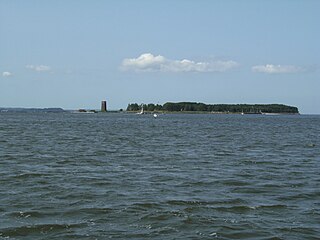
Mecklenburg-Vorpommern, also known by its anglicized name Mecklenburg–Western Pomerania, is a state in the north-east of Germany. Of the country's sixteen states, Mecklenburg-Vorpommern ranks 14th in population, It covers 23,176 km2 (8,948 sq mi) making it the sixth largest German state in area, and 16th in population density. Schwerin is the state capital and Rostock is the largest city. Other major cities include Neubrandenburg, Stralsund, Greifswald, Wismar and Güstrow.

Greifswald, officially the University and Hanseatic City of Greifswald is a city in northeastern Germany.

Rügen is Germany's largest island. It is located off the Pomeranian coast in the Baltic Sea and belongs to the state of Mecklenburg-Western Pomerania.
Vineta is the name of a mythical city at the southern coast of the Baltic Sea. The myth evolved around the tradition about the medieval emporium called Jumne, Jomsborg, Julin or similar names by the chronicles.

Swedish Pomerania was a Dominion under the Swedish Crown from 1630 to 1815, situated on what is now the Baltic coast of Germany and Poland. Following the Polish War and the Thirty Years' War, Sweden held extensive control over the lands on the southern Baltic coast, including Pomerania and parts of Livonia and Prussia.

Hiddensee is a car-free island in the Baltic Sea, located west of Germany's largest island, Rügen, on the German coast.

Ruden is a small island in the Baltic Sea, between Rügen and Usedom off the German coast. Ruden belongs to the municipality of Kröslin, in the German state (Bundesland) of Mecklenburg-Western Pomerania. Before the storm tide of All Saints Day in 1304, Ruden was probably part of a land bridge between Usedom and Rügen.

The Bay of Greifswald or Greifswald Bodden is a basin in the southwestern Baltic Sea, off the shores of Germany in the state of Mecklenburg-Vorpommern. With an area of 514 km², it is the largest Bodden of the German Baltic coast.

Wolgast is a town in the district of Vorpommern-Greifswald, in Mecklenburg-Vorpommern, Germany. It is situated on the bank of the river Peenestrom, vis-a-vis the island of Usedom on the Baltic coast that can be accessed by road and railway via a movable bascule bridge. In December 2004, the town had a population of 12,725.

Bodden are briny bodies of water often forming lagoons, along the southwestern shores of the Baltic Sea, primarily in Germany's state of Mecklenburg-Vorpommern. These lagoons can be found especially around the island of Rügen, Usedom and the Fischland-Darss-Zingst peninsula. Some of them are protected reserves, forming the Western Pomerania Lagoon Area National Park.

Koserow is a municipality on Usedom Island, in the Vorpommern-Greifswald district, in Mecklenburg-Vorpommern, Germany.

The Principality of Rügen was a Danish principality, formerly a duchy, consisting of the island of Rügen and the adjacent mainland from 1168 until 1325. It was governed by a local dynasty of princes of the Wizlawiden dynasty. For at least part of this period, Rügen was subject to the Holy Roman Empire.

Gustavia was a 19th-century unfinished Swedish town on the island of Rügen, the construction of which began and had to be aborted during the Napoleonic Wars.

FältmarskalkCarl Gustaf Wrangel was a Swedish statesman and military commander who commanded the Swedish forces in the Thirty Years', Torstenson, Bremen, Second Northern and Scanian Wars.

Bug is the name both of the westernmost tongue of land (Landzunge) on the peninsula of Wittow on the German island of Rügen, as well as the name of the former village there. Bug begins south of the village of Dranske and belongs territorially to that municipality.

The Southeast Rügen Biosphere Reserve is a biosphere reserve in the German state of Mecklenburg-Vorpommern, which covers the southeastern part of the island of Rügen, the lagoon of Rügischer Bodden between Putbus and Thiessow, the outer coast between Thiessow and Binz and the island of Vilm.

The Region of Stralsund belonged to the Prussian Province of Pomerania and existed from 1818 to 1932.
Vitslav II, variously called Vislav, Vizlav, Wislaw, Wizlaw and Witslaw in English sources was a prince of Rügen.

Historical Western Pomerania, also called Fore Pomerania, Front Pomerania or Hither Pomerania, is the western extremity of the historic region of the Duchy, later Province of Pomerania, nowadays divided between the states of Mecklenburg-Western Pomerania and Brandenburg in Germany and West Pomeranian Voivodeship in Poland.
The Wars of the Rügen Succession were two early 14th century conflicts fought primarily between Mecklenburg and Pomerania for control of the Danish Principality of Rügen on the southern Baltic Sea coast.

















